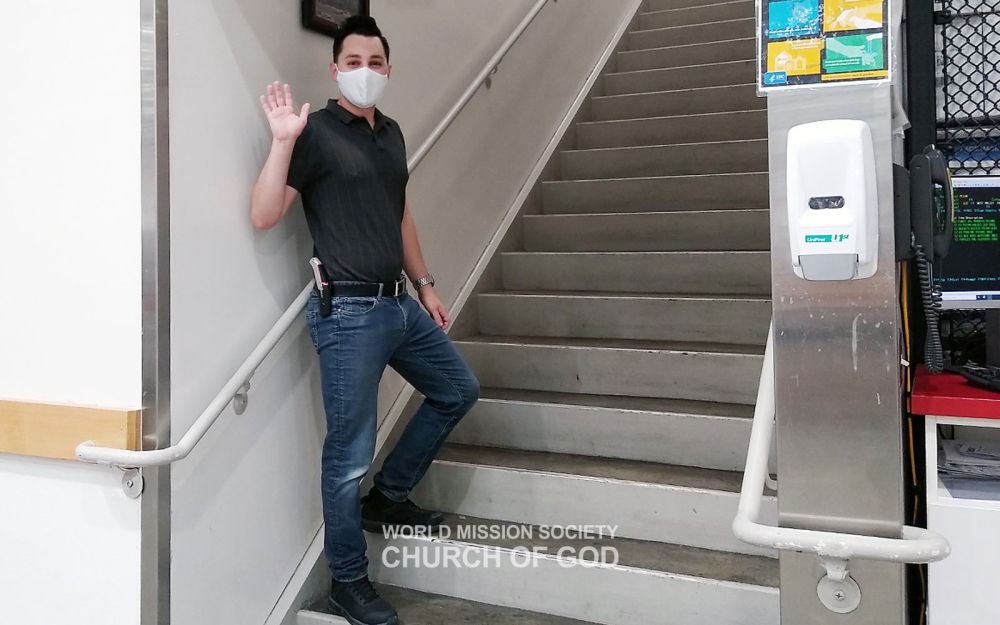Green Workplace Campaign (Eco-Friendly Activity at Workplaces): Difference between revisions
m Isaacp moved page Draft:Green Workplace Campaign (Eco-Friendly Activity at Workplaces) to Green Workplace Campaign (Eco-Friendly Activity at Workplaces) without leaving a redirect |
|||
(No difference)
| |||
Latest revision as of 13:58, 18 July 2024
Green Workplace is one of the main campaigns of ASEZ WAO, the World Mission Society Church of God Young Adult Worker Volunteer Group. This initiative involves practicing eco-friendly actions, such as saving electricity, water, and resources in the workplace to protect the environment and respond to climate change. It also includes holding seminars in workplaces as well as meetings and forums with stakeholders to raise awareness. By practicing the 12 actions suggested by ASEZ WAO, such as turning off monitors and power strips, turning off faucets, and using public transportation, one person can reduce carbon dioxide emissions by 589 kg [1,298 lbs] per year, which is equivalent to planting 93 trees. With the practice of members from various countries such as Rep. of Korea, Japan, India, Australia, and South Africa, healthy habits for the environment are being spread, centered around their workplaces.
Humanitarian Campaigns
(Campaigns For Us) • Response to COVID-19 Campaign Environmental Campaigns
(Campaigns For EARTH) • Response to Climate Change Campaign • Reducing Plastic Use Campaign • Terrestrial Ecosystem Protection Campaign • Marine Ecosystem Protection Campaign | |
| ASEZ WAO is an international volunteer group consisting of young adult workers from 7,800 Church of God locations in 175 countries. |
Purpose of Green Workplace
With the acceleration of industrialization, global warming, climate change, and environmental pollution have also accelerated. Resolving these issues has become a collective global task. 178 countries participating in the United Nations Framework Convention on Climate Change (UNFCCC) adopted the first climate change agreement in Rio de Janeiro, Brazil, in 1992, followed by the Kyoto Protocol in 1997, which affirmed their commitment to reducing greenhouse gas emissions. In 2015, 195 countries signed the Paris Agreement, expanding the scope of mandatory greenhouse gas reductions and resolving to limit the increase in global average temperature to below 1.5°C, compared with pre-industrial levels.
However, the Intergovernmental Panel on Climate Change (IPCC), in its new report released in August 2021, warned that at the current rate, global average temperatures are projected to rise by 1.5°C, compared with pre-industrial levels, between 2021 and 2040 due to climate change. According to the IPCC’s predictions, if global average temperatures rise by 1.5°C, extreme weather events such as heatwaves, heavy rainfall, and droughts currently occurring will become 8.6 times more frequent, resulting in displacement of 10 million people from their homes.[1] Each country is making efforts to address climate change through international agreements and domestic legislation,[2] but it is urgent for not only governments, environmental organizations, and businesses but also all people around the world to actively participate. This is because visible results can be seen when awareness improves and behaviors change among more people in their daily living environments. American ecologist Garrett Hardin proposed his theory of “The Tragedy of the Commons” through the journal Science in 1968. It is a warning that in unowned communal pastures, people competitively bring out more cattle, leading to the degradation of the commons. This shows that if community members use shared resources only according to their own interests, the whole community will eventually face ruin. Conversely, if community members make efforts to conserve shared resources for the benefit of everyone, communal pastures can be maintained in a healthy condition.
ASEZ WAO has initiated the Green Workplace Campaign from exactly this perspective. The initiative aims to practice environmental protection by conserving shared resources, starting from workplaces where people spend a significant amount of their day. There is research indicating that wastefulness regarding public goods is prevalent in many businesses. In a survey conducted by a Korean employment portal site targeting employees, it was found that one out of two respondents admitted to using office supplies such as photocopy paper or disposable cups excessively.[3] In Japan, under Article 245 of the Penal Code, electricity is considered a property.[4] This provision serves to caution against indiscriminate use of electricity in workplaces.[5]
Campaign Introduction
ASEZ WAO operates with members from 175 countries worldwide. Through the Green Workplace Campaign, it encourages its members to conserve public resources in their workplaces, minimize the use of disposable items, and foster participation in the campaign among colleagues. The primary goal of the campaign is to mitigate greenhouse gas emissions and address climate change. The objective of the Green Workplace is for members to adopt 12 practical actions in their daily routines alongside workers around the world, with the aim of reducing approximately 589 kg (1,298 lbs) of carbon dioxide emissions per person per year. Members actively engage in saving power and water and living a low-impact lifestyle in their workplaces. Moreover, they promote individual awareness through diverse actions and foster global cooperation among companies and institutions via conferences and forums.[6] When workers implement the 12 specified actions, the anticipated annual reduction in carbon dioxide emissions and the afforestation impact are as follows.
| Category | Item | How to Practice | CO2 Reduction | Effect of Planting Trees |
| Turning Off Monitors | Switch to power-saving mode or turn off computers during lunch breaks, intervals, and other periods of non-use to save energy. | 17.7 kg
(39 lbs) |
3 Trees | |
| Switching Off Power Strips | Disconnect the cords of unused products and power down the multi-outlet power strip. | 12.6 kg
(27.8 lbs) |
2 Trees | |
| Using Stairs | Use the stairs for floors located on levels 1 through 4. | 4.7 kg
(10 lbs) |
1 Tree | |
| Using a Cup When Brushing Teeth | Use a personal toothbrush cup during dental hygiene routines. | 6.9 kg
(15.2 lbs) |
2 Trees | |
| Turning Off Faucets | Turn off the faucet while applying soap. Use water-saving devices. | 18.9 kg
(41.7 lbs) |
3 Trees | |
| Using a Washing Bowl | When washing dishes in the kitchen sink, use a basin to save water. | 4.8 kg
(10.6 lbs) |
1 Tree | |
| Using Public Transportation | Use public transportation instead of a private vehicle once a week. | 469.4 kg (1,035 lbs) | 71 Trees | |
| Riding a Bicycle | Walk or cycle once a week. | 25.1 kg
(55 lbs) |
4 Trees | |
| Reusing Printer Paper | Use 10 sheets of one-side printed waste paper a day to save office paper. | 10.9 kg
(24 lbs) |
2 Trees | |
| Using a Personal Cup | Use a personal cup instead of paper or plastic cups. | 3.5 kg
(7.7 lbs) |
1 Tree | |
| Using a Handkerchief | Use personal hand towels instead of hand dryers or paper towels. | 10.5 kg
(23 lbs) |
2 Trees | |
| Emptying Your Email Box | Delete unnecessary emails and empty the email box.
Deleting a single email has the potential to reduce 4 grams of carbon dioxide emissions generated by data centers.[7] (In 2021, the total goal is to reduce CO2 by 2,021 kg [4,456 lbs].) |
4 kg
(8.8 lbs) |
1 Tree | |
| When emptying the email box once a year | 589 kg (1,300 lbs) | 93 Trees | ||
Green Workplace aligns with the Sustainable Development Goals (SDGs), the biggest common goal of the international society: Goal 7 (Affordable and Clean Energy), Goal 11 (Sustainable Cities and Communities), and Goal 13 (Climate Action).
Current Activity Status
Since its launch in November 2020 in the Rep. of Korea, Green Workplace Campaign has been actively expanding to include locations such as the United States, Japan, India, Australia, the Philippines, Cambodia, Malaysia, and South Africa. In the New Windsor area of the United States, ASEZ WAO members hosted Green Workplace seminars, inviting their company executives and employees. Similarly, in a manufacturing company in Korea, they conducted seminars for employees, distributing mugs and enhancing interest in the Green Workplace Campaign and greenhouse gas reduction.[8][9] Through these activities, participation in this campaign by the members and worldwide workers is progressively increasing.
See also
References
- ↑ Global Warming of 1.5 ºC, IPCC
- ↑ EU leaders agree to reduce emissions after all-night talks, AP News, December 12, 2020
- ↑ 1 in 2 Office Workers Take Company Supplies Home: Majority Utilize Writing Utensils Personally…Excessive Copy Paper Waste, ET News, June 16, 2011
- ↑ 日本 刑法 第二百四十五条(Japan Criminal Code Article 245), e-GOV 法令検索
- ↑ Charged with 'Embezzlement' for Charging Phone at Work?, Money Today, February 26, 2018
- ↑ Green Workplace, ASEZ WAO Official Website
- ↑ The environmental cost of email, Fight Climate Change, May 22, 2022
- ↑ Environmental Protection Begins at Workplaces!, ASEZ WAO Official Website
- ↑ ASEZ WAO Carried Out Regular Volunteer Services, WATV.org, December 18, 2020




